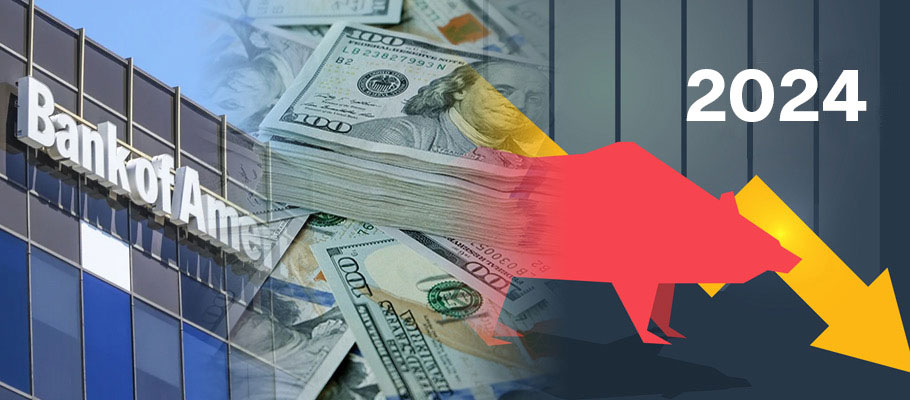
Published: December 6th, 2023
Newly released forecasts by Bank of America (BofA) for 2024 have positioned the bank as a US Dollar bear, disagreeing with consensus and suggesting that interest rate reductions by the US Federal Reserve will be more influential than cuts made by other central banks.
BofA analysts believe the Euro to Dollar (EURUSD) exchange rate will pass the 1.10 level in the next few months and keep moving the pair closer to fair value. They caution, however, that EUR may not be ‘supported on its own merits.’
Comparing annual market forecasts by the bank’s FX Strategy unit, BofA was more bullish than consensus on the Greenback last year, and is now less bullish than the rest as it looks ahead to 2024.
The expected weakness in USD is based on the belief that America's economic growth will stall and lead to a smaller outperformance gap for the USA versus other countries, something bank analysts refer to as a 'US recoupling’ with the rest of the globe.
BofA's analysts are looking for three rate cuts from the Fed beginning in June, which is similar to what they expected from central bankers at the ECB.
But the report also says that rate cuts by Washington ‘matter more for the market’, and the negative impact on the Greenback may be outsized relative to countries where central bankers are also pursuing cuts.
BofA analysts expect Fed rate cuts to support market sentiment, and the ‘risk on' attitude it perceives at the moment is consistent with a weaker Dollar.
Bank of America's models calculate that USD is currently overvalued, with an unwind in 2024 that will push the Euro-Dollar rate up to 1.15 next year.
‘It was a different story in February when EUR was pegged for losses against the Greenback. Forex analysts at MUFG expected the Euro was to remain on the back foot against the US Dollar. A weekly market briefing said that USD’s comeback had not been hindered by risk-off sentiment, or trader concerns about the imminent release of minutes by the US Fed’s open markets committee.
With investors also shrugging off PCE deflator data due later that week, MUFG said traders may be witnessing the near-term return of Dollar dominance.
‘The upward adjustment to a higher terminal rate and cooling rate cut expectations for later in 2023 have spurred new life into the strong USD trade we saw at the end of 2022,’ said MUFG’s briefing.
Adding wind to USD’s sails was rising investor anticipation around the Federal Reserve's peak interest rate hiking cycle.
In January, consensus had the last rate rise set for March, but an additional two hikes were then been added to the schedule.
The likelihood of a rate cut in the latter part of 2023 had receded, giving the Dollar support after an underwhelming end to 2022 and beginning to 2023.
EURUSD rushed toward 1.10 in January but fekk back again in early February as new US economic data flummoxed analysts, who sent mixed signals into the market.
A surprising mix of strong wage data, labour market dynamics, inflation figures and retail sales suggested the American economy was robust enough to achieve the Fed’s above-target inflation levels. EURUSD started to retrace previous gains as a result.
‘Stronger American growth data blended with firmer inflation at the beginning of 2023 has added optimism to markets. Forex traders are now pricing-in a more hawkish outlook for Fed policy’.
Going into March of 2022, spiking oil prices were pushing the Euro toward multi-year lows as forex traders bet that the European Central Bank would delay plans to raise interest rates later in the year.
Prices for Brent Crude surged above USD 130 per barrel in March 2022, the highest level for almost 13 years. Wholesale gas prices meanwhile more than doubled from the previous month on fears that the US and EU were considering an unequivocal ban on Russian oil.
The US did move forward with plans to ban purchases of Russian oil and gas, with other G7 countries following suit. European natural gas prices responded by hitting an all-time high.
In a note to investors, the FX Strategy unit at Crédit Agricole wrote that news of major Western importers considering coordinated sanctions against Russian energy exports sent oil and other commodity prices soaring, especially in Asia.
‘Conjecture around ramped up sanctions in the energy sector has started with a bang. Stocks have tumbled and crude prices are soaring on Asian markets as traders' price-in the impact of a US and EU ban on Russian crude supplies’.
In response to the supply shock, Crédit Agricole said a ‘binary move’ in currency markets was underway, one that favoured the fiats of energy exporting countries. Net energy importing countries, in contrast, would see their currencies take a hit.
In a weekly currency research briefing, Barclays said at the time that the Ukraine conflict had delivered a negative EUR shock.
‘In the near term, the Euro has scope to trade lower given the potential stagflation effect on the Eurozone. Looking further ahead, the war could compel more structural integration by member states that provides EUR with support.’
The Pound to Euro exchange rate reached 1.2177 on Tuesday 8th March, the highest level since June 2016. The Euro to Dollar rate dipped to 1.0857, the lowest level since April 2020.
Economists expected surging oil and gas prices to drag the Eurozone economy downward this year due to its reliance on Russian gas and deep integration with Russia's energy industry.
In an interview with Bloomberg, an analyst from BMO Capital Markets European FX Strategy unit said that a negative relationship would strengthen between the price of crude oil and EUR/USD.
There were also concerns in the market that a dip in Eurozone economic growth could see the ECB cool enthusiasm for its planned post-COVID normalisation of monetary policy. A change in course might have limited Eurozone bond yields and pulled the Euro down further.